steering Abarth 500 2015 Owner handbook (in English)
[x] Cancel search | Manufacturer: ABARTH, Model Year: 2015, Model line: 500, Model: Abarth 500 2015Pages: 215, PDF Size: 19.08 MB
Page 127 of 215
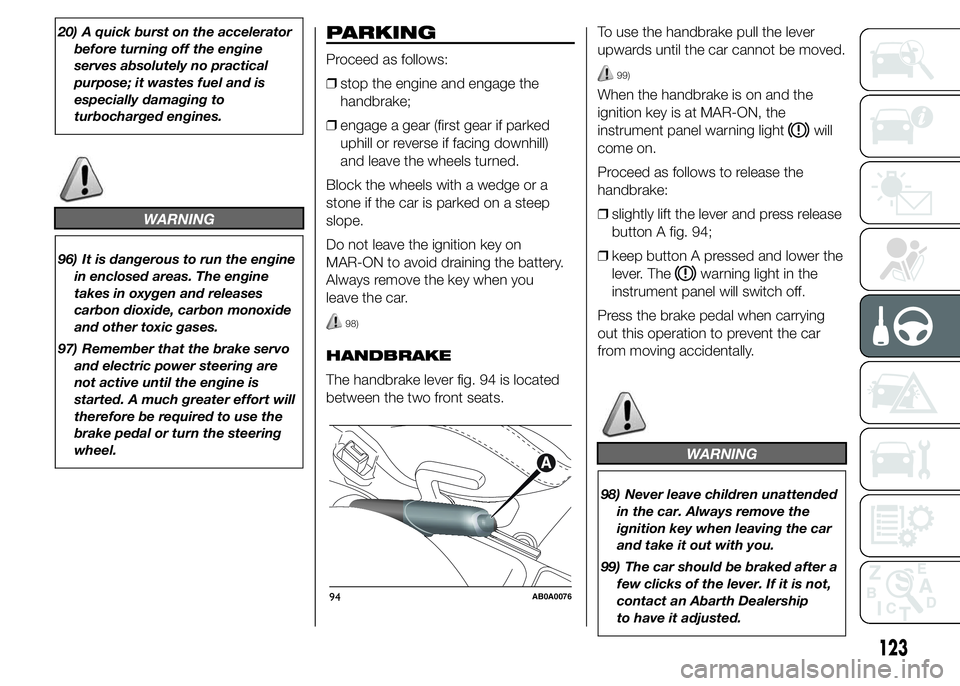
20) A quick burst on the accelerator
before turning off the engine
serves absolutely no practical
purpose; it wastes fuel and is
especially damaging to
turbocharged engines.
WARNING
96) It is dangerous to run the engine
in enclosed areas. The engine
takes in oxygen and releases
carbon dioxide, carbon monoxide
and other toxic gases.
97) Remember that the brake servo
and electric power steering are
not active until the engine is
started. A much greater effort will
therefore be required to use the
brake pedal or turn the steering
wheel.
PARKING
Proceed as follows:
ŌØÆstop the engine and engage the
handbrake;
ŌØÆengage a gear (first gear if parked
uphill or reverse if facing downhill)
and leave the wheels turned.
Block the wheels with a wedge or a
stone if the car is parked on a steep
slope.
Do not leave the ignition key on
MAR-ON to avoid draining the battery.
Always remove the key when you
leave the car.
98)
HANDBRAKE
The handbrake lever fig. 94 is located
between the two front seats.To use the handbrake pull the lever
upwards until the car cannot be moved.
99)
When the handbrake is on and the
ignition key is at MAR-ON, the
instrument panel warning light
will
come on.
Proceed as follows to release the
handbrake:
ŌØÆslightly lift the lever and press release
button A fig. 94;
ŌØÆkeep button A pressed and lower the
lever. The
warning light in the
instrument panel will switch off.
Press the brake pedal when carrying
out this operation to prevent the car
from moving accidentally.
WARNING
98) Never leave children unattended
in the car. Always remove the
ignition key when leaving the car
and take it out with you.
99) The car should be braked after a
few clicks of the lever. If it is not,
contact an Abarth Dealership
to have it adjusted.
94AB0A0076
123
Page 134 of 215
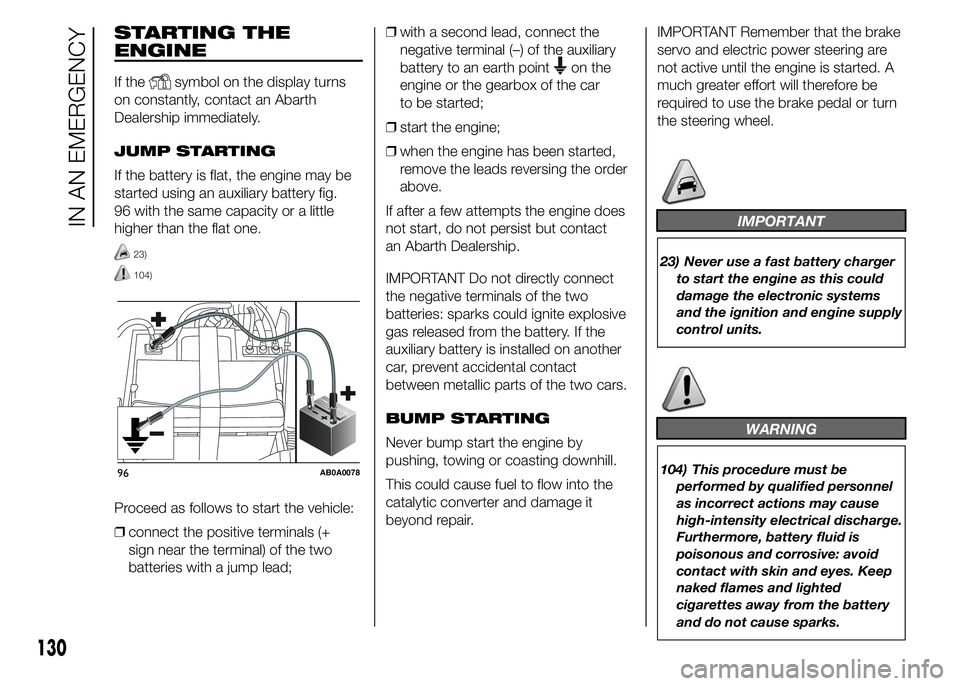
STARTING THE
ENGINE
If thesymbol on the display turns
on constantly, contact an Abarth
Dealership immediately.
JUMP STARTING
If the battery is flat, the engine may be
started using an auxiliary battery fig.
96 with the same capacity or a little
higher than the flat one.
23)
104)
Proceed as follows to start the vehicle:
ŌØÆconnect the positive terminals (+
sign near the terminal) of the two
batteries with a jump lead;ŌØÆwith a second lead, connect the
negative terminal (ŌĆō) of the auxiliary
battery to an earth point
on the
engine or the gearbox of the car
to be started;
ŌØÆstart the engine;
ŌØÆwhen the engine has been started,
remove the leads reversing the order
above.
If after a few attempts the engine does
not start, do not persist but contact
an Abarth Dealership.
IMPORTANT Do not directly connect
the negative terminals of the two
batteries: sparks could ignite explosive
gas released from the battery. If the
auxiliary battery is installed on another
car, prevent accidental contact
between metallic parts of the two cars.
BUMP STARTING
Never bump start the engine by
pushing, towing or coasting downhill.
This could cause fuel to flow into the
catalytic converter and damage it
beyond repair.IMPORTANT Remember that the brake
servo and electric power steering are
not active until the engine is started. A
much greater effort will therefore be
required to use the brake pedal or turn
the steering wheel.
IMPORTANT
23) Never use a fast battery charger
to start the engine as this could
damage the electronic systems
and the ignition and engine supply
control units.
WARNING
104) This procedure must be
performed by qualified personnel
as incorrect actions may cause
high-intensity electrical discharge.
Furthermore, battery fluid is
poisonous and corrosive: avoid
contact with skin and eyes. Keep
naked flames and lighted
cigarettes away from the battery
and do not cause sparks.96AB0A0078
130
IN AN EMERGENCY
Page 151 of 215
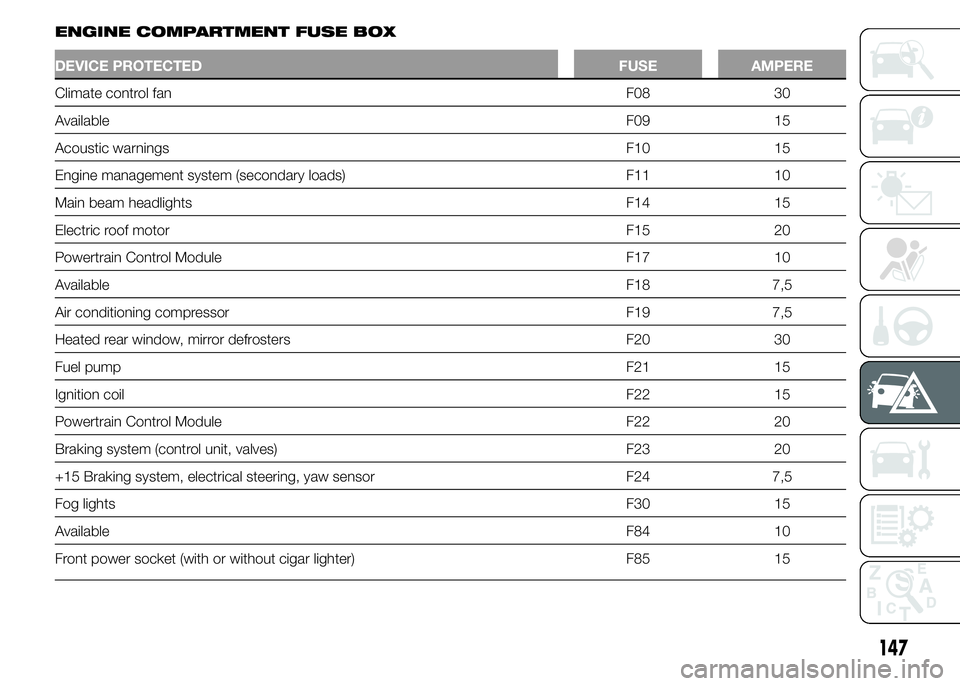
ENGINE COMPARTMENT FUSE BOX
DEVICE PROTECTED FUSE AMPERE
Climate control fan F08 30
AvailableF09 15
Acoustic warnings F10 15
Engine management system (secondary loads) F11 10
Main beam headlights F14 15
Electric roof motor F15 20
Powertrain Control Module F17 10
AvailableF18 7,5
Air conditioning compressor F19 7,5
Heated rear window, mirror defrosters F20 30
Fuel pumpF21 15
Ignition coilF22 15
Powertrain Control Module F22 20
Braking system (control unit, valves) F23 20
+15 Braking system, electrical steering, yaw sensor F24 7,5
Fog lightsF30 15
AvailableF84 10
Front power socket (with or without cigar lighter) F85 15
147
Page 154 of 215
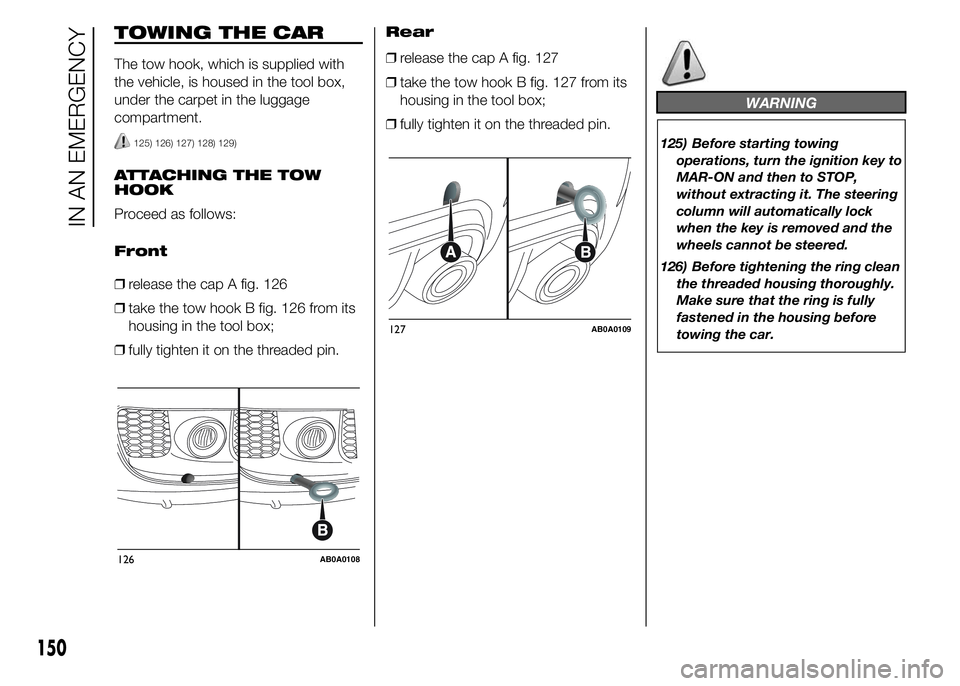
TOWING THE CAR
The tow hook, which is supplied with
the vehicle, is housed in the tool box,
under the carpet in the luggage
compartment.
125) 126) 127) 128) 129)
ATTACHING THE TOW
HOOK
Proceed as follows:
FrontRear
ŌØÆrelease the cap A fig. 127
ŌØÆtake the tow hook B fig. 127 from its
housing in the tool box;
ŌØÆfully tighten it on the threaded pin.
WARNING
125) Before starting towing
operations, turn the ignition key to
MAR-ON and then to STOP,
without extracting it. The steering
column will automatically lock
when the key is removed and the
wheels cannot be steered.
126) Before tightening the ring clean
the threaded housing thoroughly.
Make sure that the ring is fully
fastened in the housing before
towing the car.
126AB0A0108
127AB0A0109
150
IN AN EMERGENCY
ŌØÆrelease the cap A fig. 126
ŌØÆtake the tow hook B fig. 126 from its
housing in the tool box;
ŌØÆfully tighten it on the threaded pin.
Page 155 of 215

127) The front and rear tow hooks
should be used only for
emergencies on the road. You are
allowed to tow the vehicle for
short distances using an
appropriate device in accordance
with the highway code (a rigid
bar), to move the vehicle on the
road in readiness for towing or
transport via a breakdown vehicle.
Tow hooks MUST NOT be used
to tow vehicles off the road or
where there are obstacles and/or
for towing operations using cables
or other non-rigid devices.
Respecting the above conditions,
towing must take place with two
vehicles (one towing, the other
towed) aligned as much as
possible along the same centre
line.128) Whilst towing, remember that
as the assistance of the brake
servo and the electric power
steering is not available, greater
force needs to be exerted on
the brake pedal and more effort is
required on the steering wheel.
Do not use flexible cables when
towing and avoid jerky
movements. While towing, make
sure that the trailer hitch does not
damage any components it is
touching. When towing the car,
you must comply with all specific
traffic regulations, both in terms
of the towing device and
behaviour on the road. Do not
start the engine while towing the
car.
129) Because of its conformation,
the car cannot be loaded onto
railway carriages and transported.
151
Page 168 of 215

WHEELS AND TYRES
Check the pressure of each tyre,
including the space-saver wheel,
approximately every two weeks and
before long journeys: the pressure
should be checked with the tyre rested
and cold.
140) 141) 142) 143)
It is normal for the pressure to increase
when the car is used; for the correct
tyre inflation pressure, see "Wheels" in
the "Technical specifications" chapter.
Incorrect pressure causes abnormal
tyre wear fig. 129:
Anormal pressure: tread evenly worn.
Blow pressure: tread particularly worn
at the edges.
Chigh pressure: tread particularly worn
in the centre.The tyres must be replaced when the
tread is less than 1.6 mm thick. In
any case, follow the laws in force in the
country you are in.
IMPORTANT INFORMATION
ŌØÆAs far as possible, avoid sharp
braking, screech starts and violent
shocks against pavements, potholes
or other hard obstacles. Driving for
long stretches over uneven roads can
damage the tyres;
ŌØÆperiodically check that the tyres have
no cuts in the side wall, abnormal
swelling or irregular tread wear.
Contact an Abarth Dealership
if required.
ŌØÆavoid overloading the car when
travelling: this may cause serious
damage to the wheels and tyres;
ŌØÆif a tyre is punctured, stop
immediately and change it to avoid
damage to the tyre, the rim,
suspensions and steering system;
ŌØÆtyres age even if they are not used a
great deal. Cracks in the tread and
on the side walls are a sign of ageing.
In any event, have the tyres checked
by specialised personnel if they
have been fitted for longer than 6
years. Also remember to check the
space-saver wheel with particular
care;ŌØÆin the case of replacement, always fit
new tyres, avoiding those of
unknown origin;
ŌØÆif a tyre is changed, also change the
inflation valve;
ŌØÆto allow even wear between the front
and rear tyres, it is advisable to
change them over every 10ŌĆō15
thousand kilometres, keeping them
on the same side of the car to avoid
inverting the direction of rotation.
WARNING
140) Remember that the road
holding qualities of your car also
depend on correct tyre pressures.
141) If tyre pressure is too low, it
may overheat and be severely
damaged as a result.
142) Do not exchange the tyres from
the left to the right of the car and
vice versa.
143) Never submit alloy rims to
repainting treatments requiring
the use of temperatures
exceeding 150┬░C. The mechanical
properties of the wheels could
be impaired.
129AB0A0111
164
SERVICING AND MAINTENANCE
Page 175 of 215

TECHNICAL SPECIFICATIONS
Everything you may find useful for
understanding how your vehicle
is made and works is contained in this
chapter and illustrated with data, tables
and graphics. For the enthusiasts and
the technician, but also just for those
who want to know every detail of their
car.IDENTIFICATION DATA....................172
ENGINE CODES - BODYWORK
VERSIONS ......................................173
ENGINE ..........................................174
FUEL SUPPLY .................................175
TRANSMISSION .............................176
BRAKES .........................................177
SUSPENSION .................................178
STEERING ......................................179
WHEELS .........................................180
DIMENSIONS ..................................184
PERFORMANCE .............................185
WEIGHTS........................................186
SUPPLIES .......................................187
FLUIDS AND LUBRICANTS ............188
FUEL CONSUMPTION ....................191
CO2 EMISSIONS ............................192
PRESCRIPTIONS FOR HANDLING
THE VEHICLE AT THE END OF ITS
LIFE ................................................193
RADIOFREQUENCY REMOTE
CONTROL: MINISTERIAL
APPROVALS ...................................194
WHAT TO DO IF ..............................195
171
Page 183 of 215

STEERING
Version 1.4 TB PETROL ABARTH
Typerack and pinion with dual strategy electric power steering (normal/
sport)
Turning circle kerb to kerb (m) 10.8
179
Page 211 of 215
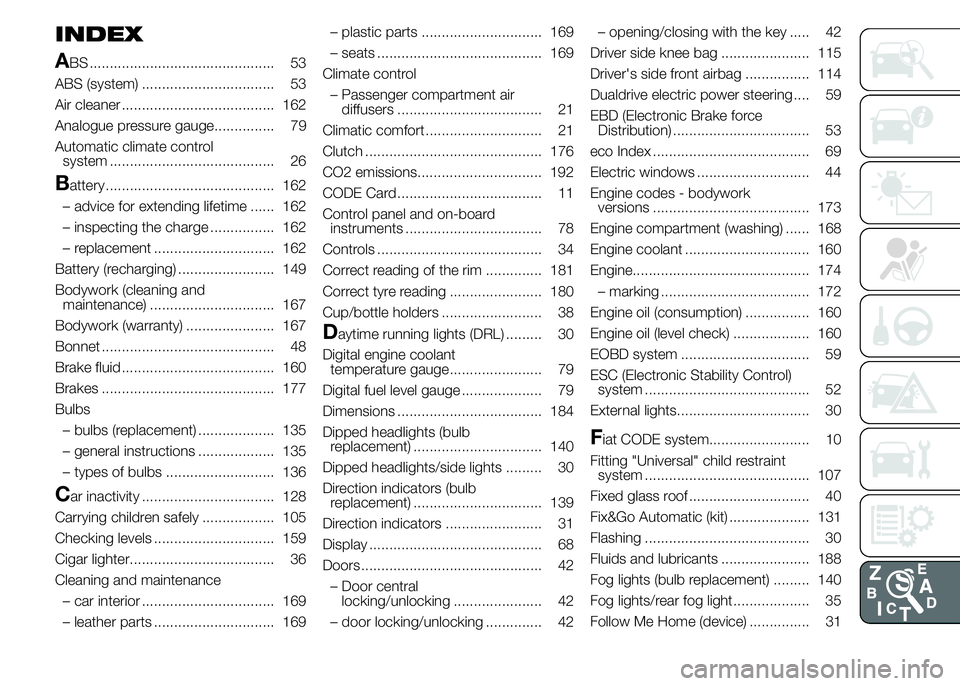
INDEX
A
BS .............................................. 53
ABS (system) ................................. 53
Air cleaner ...................................... 162
Analogue pressure gauge............... 79
Automatic climate control
system ......................................... 26
Battery .......................................... 162
ŌĆō advice for extending lifetime ...... 162
ŌĆō inspecting the charge ................ 162
ŌĆō replacement .............................. 162
Battery (recharging) ........................ 149
Bodywork (cleaning and
maintenance) ............................... 167
Bodywork (warranty) ...................... 167
Bonnet ........................................... 48
Brake fluid ...................................... 160
Brakes ........................................... 177
Bulbs
ŌĆō bulbs (replacement) ................... 135
ŌĆō general instructions ................... 135
ŌĆō types of bulbs ........................... 136
Car inactivity ................................. 128
Carrying children safely .................. 105
Checking levels .............................. 159
Cigar lighter.................................... 36
Cleaning and maintenance
ŌĆō car interior ................................. 169
ŌĆō leather parts .............................. 169ŌĆō plastic parts .............................. 169
ŌĆō seats ......................................... 169
Climate control
ŌĆō Passenger compartment air
diffusers .................................... 21
Climatic comfort ............................. 21
Clutch ............................................ 176
CO2 emissions............................... 192
CODE Card .................................... 11
Control panel and on-board
instruments .................................. 78
Controls ......................................... 34
Correct reading of the rim .............. 181
Correct tyre reading ....................... 180
Cup/bottle holders ......................... 38
Daytime running lights (DRL) ......... 30
Digital engine coolant
temperature gauge....................... 79
Digital fuel level gauge .................... 79
Dimensions .................................... 184
Dipped headlights (bulb
replacement) ................................ 140
Dipped headlights/side lights ......... 30
Direction indicators (bulb
replacement) ................................ 139
Direction indicators ........................ 31
Display ........................................... 68
Doors ............................................. 42
ŌĆō Door central
locking/unlocking ...................... 42
ŌĆō door locking/unlocking .............. 42ŌĆō opening/closing with the key ..... 42
Driver side knee bag ...................... 115
Driver's side front airbag ................ 114
Dualdrive electric power steering .... 59
EBD (Electronic Brake force
Distribution) .................................. 53
eco Index ....................................... 69
Electric windows ............................ 44
Engine codes - bodywork
versions ....................................... 173
Engine compartment (washing) ...... 168
Engine coolant ............................... 160
Engine............................................ 174
ŌĆō marking ..................................... 172
Engine oil (consumption) ................ 160
Engine oil (level check) ................... 160
EOBD system ................................ 59
ESC (Electronic Stability Control)
system ......................................... 52
External lights................................. 30
Fiat CODE system......................... 10
Fitting "Universal" child restraint
system ......................................... 107
Fixed glass roof .............................. 40
Fix&Go Automatic (kit) .................... 131
Flashing ......................................... 30
Fluids and lubricants ...................... 188
Fog lights (bulb replacement) ......... 140
Fog lights/rear fog light................... 35
Follow Me Home (device) ............... 31
Page 213 of 215

Refuelling the car ........................... 64
Replacing an exterior bulb .............. 139
Replacing an interior bulb ............... 142
Rev counter ................................... 79
Rim Protector (tyres)....................... 181
Rims and tyres ............................... 180
Roof lights...................................... 33
Roof rack/ski rack .......................... 50
Rubber hoses ................................ 165
Safety ........................................... 102
ŌĆō seat belts .................................. 102
Saving fuel ..................................... 125
SBR system ................................... 102
Scheduled Servicing Plan ............... 155
Seat belts
ŌĆō using the seat belts ................... 102
Seat belts (maintenance) ................ 104
Seats ............................................. 15
ŌĆō Front seats ................................ 15
Sensors
ŌĆō parking ...................................... 62
Side airbags (Side bags -
Window bags) .............................. 118
Side bags (front side airbags) ......... 118
Side lights/daytime running lights
(bulb replacement) ....................... 140
Snow chains .................................. 127
Snow tyres ..................................... 127
Speedometer ................................. 79
Sport front seats ............................ 16SPORT .......................................... 34
Starting the engine ......................... 122
Starting the engine ......................... 130
Steering ......................................... 179
Steering wheel ............................... 18
Storage compartment .................... 37
Storage compartment under
passenger seat ............................ 38
Sun roof ......................................... 40
Sun visors ...................................... 37
Supplies ......................................... 187
Suspension .................................... 178
Symbols......................................... 10
Technical specifications ................ 172
The keys ........................................ 11
ŌĆō CODE Card ............................... 11
ŌĆō Key without remote control........ 11
ŌĆō Key with remote control............. 12
Third brake lights (bulb
replacement) ................................ 141
Towing the car ............................... 150
Towing trailers ................................ 126
Transmission .................................. 176
TRIP button.................................... 81
Trip Computer ................................ 80
TTC system ................................... 55
Ty r e s
ŌĆō inflation pressures ..................... 183
ŌĆō snow tyres................................. 182
ŌĆō tyres provided ........................... 182Tyres - maintenance ....................... 164
Using the gearbox ........................ 124
Warning lights and messages ....... 83
Weights.......................................... 186
Wheel rims
ŌĆō dimensions................................ 182
ŌĆō wheels and tyres ....................... 164
Wheels and tyres ........................... 164
ŌĆō tyre inflation pressure................. 183
Window bags (side airbags for
head protection) ........................... 118
Window cleaning............................ 32
Windows (cleaning) ........................ 168
Windscreen/rear window washer
fluid .............................................. 160
Windscreen/rear window wiper
(blades) ........................................ 165
Windscreen washer (jets) ............... 166
Windscreen wiper/washer .............. 32